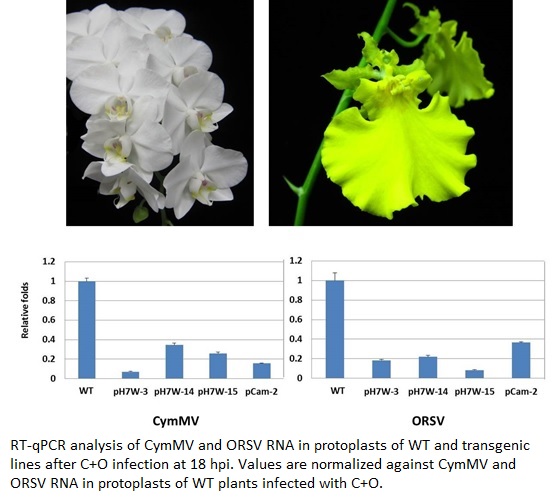[Na-Sheng Lin] Dual resistance of transgenic plants against Cymbidium mosaic virus and Odontoglossum ringspot virus
POST: Maureen ChuangThe Orchidaceae is the largest and most diverse family of flowering plants. Because of the fascinating array of colors, delicate flower shapes, and fragrant blooms, orchids have become popular and valuable ornamental plants in the market. Taxonomically distinct Cymbidium mosaic potexvirus (CymMV) and Odontoglossum ringspot tobamovirus (ORSV) are two of the most prevalent viruses worldwide; when co-infecting orchids, they cause synergistic symptoms. Because of the huge economic loss in quality and quantity in the orchid industry with virus-infected orchids, virus-resistant orchids are urgently needed. To date, no transgenic resistant lines against these two viruses have been reported. Dr. Na-Sheng Lin’s group generated transgenic Nicotiana benthamiana expressing various constructs of partial CymMV and ORSV genomes. Several transgenic lines grew normally and remained symptomless after mixed inoculation with CymMV and ORSV. The replication of CymMV and ORSV was approximately 70% - 90% lower in protoplasts of transgenic lines than wild-type (WT) plants. Of note, extremely low or no viral RNA or capsid protein of CymMV and ORSV was detected in systemic leaves of transgenic lines after co-infection. Grafting experiments further revealed that CymMV and ORSV trafficked extremely inefficiently from co-infected WT stocks to transgenic scions, presumably due to RNA-mediated interference. This study reports the first successful creation of dual resistant transgenic lines against CymMV and ORSV and shed light on the commercial development of transgenic orchid production to combat the global viral threat. The article was reported in “Scientific Reports. 2019. 9:10230.” https://doi.org/10.1038/s41598-019-46695-7.
